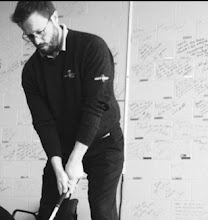The pitch shot is little more than an elongated chip. The fundamentals are exactly the same as the chip, and the swing technique is based on the same philosophy. So how is a pitch different than the basic chip? The difference is the length and speed of the swing, which ultimately makes it possible to produce a wider variety of shots than is possible with the chipping motion. The pitching swing is longer in the terms of your arm swing, wrist cock, shoulder turn and footwork. As a result, you generate much more clubhead speed. When you add speed to the equation, a new world opens up in terms of what you can do with the ball. With speed comes the possibility of increasing your backspin, hitting the ball higher than normal and producing good shots from difficult lies. The pitch includes high, soft shots from around the green as well as the half wedge from 20 to 35 meters – a shot that causes most amateurs to become nervous.

 Here I’m playing a 25 meter shot to my target. Align with your stance and wedge squarely at the target and position the ball just inside the left heel, the shaft should be fairly vertical this is to use the bounce on the sole of the club, which maintains the loft of the club, and stops the club face from shutting during the backswing, and the leading edge of the club digging into the ground during impact. The bodyweight should be positioned towards the left side in the address position so that the middle of the sternum is in line over the ball.
Here I’m playing a 25 meter shot to my target. Align with your stance and wedge squarely at the target and position the ball just inside the left heel, the shaft should be fairly vertical this is to use the bounce on the sole of the club, which maintains the loft of the club, and stops the club face from shutting during the backswing, and the leading edge of the club digging into the ground during impact. The bodyweight should be positioned towards the left side in the address position so that the middle of the sternum is in line over the ball.  Here are three different lofted wedges 48’ 53’ and 58’ it is important select the appropriate combination of gap, sand and lob wedges to provide you with the proper short game distance control.What is bounce on a wedge? Bounce is built into the sole of a wedge to keep it from digging into the turf or sand. The greater the bounce, the more the sole resists digging. Bounce helps prevent "fat" shots by keeping the club moving through the turf or sand.Having enough bounce is particularly important on all shots. Too much bounce can make shots from firm conditions more difficult to execute.
Here are three different lofted wedges 48’ 53’ and 58’ it is important select the appropriate combination of gap, sand and lob wedges to provide you with the proper short game distance control.What is bounce on a wedge? Bounce is built into the sole of a wedge to keep it from digging into the turf or sand. The greater the bounce, the more the sole resists digging. Bounce helps prevent "fat" shots by keeping the club moving through the turf or sand.Having enough bounce is particularly important on all shots. Too much bounce can make shots from firm conditions more difficult to execute.





















No comments:
Post a Comment